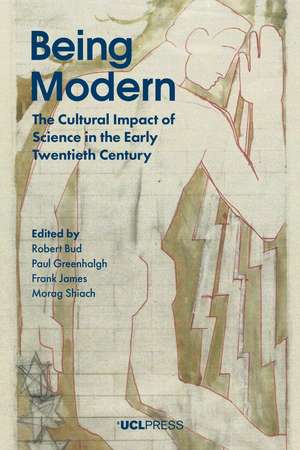Being Modern: The Cultural Impact of Science in the Early Twentieth Century
Editat de Robert Bud, Paul Greenhalgh, Frank James, Morag Shiachen Limba Engleză Hardback – 14 mar 2019
In the early decades of the twentieth century, engagement with science was commonly used as an emblem of modernity. This phenomenon is now attracting increased attention in different historical specialties. Being Modern builds on this recent interest to explore engagements with science across culture from the end of the nineteenth century to approximately 1940. Addressing the breadth of cultural forms in Britain and the western world from the architecture of Le Corbusier to working class British science fiction, Being Modern paints a rich picture. Seventeen distinguished contributors from a range of fields, including the history of science and technology, art, architecture, and English culture and literature examine the issues involved. The book will be a valuable resource for further examination of culture as an interconnected web of which science was a critical part.
Preț: 367.16 lei
Nou
Puncte Express: 551
Preț estimativ în valută:
70.29€ • 73.06$ • 58.28£
70.29€ • 73.06$ • 58.28£
Carte indisponibilă temporar
Doresc să fiu notificat când acest titlu va fi disponibil:
Se trimite...
Preluare comenzi: 021 569.72.76
Specificații
ISBN-13: 9781787353954
ISBN-10: 1787353958
Pagini: 454
Dimensiuni: 159 x 235 x 48 mm
Greutate: 1 kg
Editura: UCL Press
Colecția UCL Press
ISBN-10: 1787353958
Pagini: 454
Dimensiuni: 159 x 235 x 48 mm
Greutate: 1 kg
Editura: UCL Press
Colecția UCL Press
Notă biografică
Robert Bud is Research Keeper at the Science Museum in London. His award-winning publications in the history of science include studies of biotechnology and scientific instruments. Paul Greenhalgh is Director of the Sainsbury Centre at the University of East Anglia, and Professor of Art History there. He has published extensively in the history of art, design, and the decorative arts in the early modern period. Frank James is Professor of History of Science at the Royal Institution and University College London. His research formerly centred on Faraday, but now focuses on Davy. Morag Shiach is Professor of Cultural History at Queen Mary, University of London. She has published extensively on the cultural history of modernism and on modernism and labour.
Cuprins
"Being Modern: Introduction
Robert Bud and Morag Shiach
Section 1: Science, modernity and culture
1 Multiple modernisms in concert: the sciences, technology and culture in Vienna around 1900
Mitchell G. Ash
2 The cinematic sound of industrial modernity: first notes
Tim Boon
3 Woolf’s atom, Eliot’s catalyst and Richardson’s waves of
light: science and modernism in 1919
Morag Shiach
4 T.S. Eliot: modernist literature, disciplines and the
systematic pursuit of knowledge
Kevin Brazil
Section 2: Tensions over science
5 Modernity and the ambivalent significance of applied science: motors, wireless, telephones and poison gas
Robert Bud
6 ‘The springtime of science’: modernity and the future and
past of science
Frank A.J.L. James
7 ‘Come on you demented modernists, let’s hear from you’:
science fans as literary critics in the 1930s
Charlotte Sleigh
Section 3:
Mathematics and physics
8 Modern by numbers: modern mathematics as a model for
literary modernism
Nina Engelhardt
9 Sculpture in the Belle Epoque: mathematics, art and
apparitions in school and gallery
Lewis Pyenson
10 Architecture, science and purity
Judi Loach
11 A Portrait of the Scientist as a Young Ham: wireless,
modernity and interwar nuclear physics
Jeff Hughes
12 Whose modernism, whose speed? Designing mobility for the
future, 1880s–1945
Ruth Oldenziel
Section 4: Life, biology and the organicist metaphor
13 Ludwig Koch’s birdsong on wartime BBC radio: knowledge,
citizenship and solace
Michael Guida
14 ‘More Modern than the Moderns’: performing cultural
evolution in the Kibbo Kift Kindred
Annebella Pollen
15 Organicism and the modern world: from A.N. Whitehead to
Wyndham Lewis and D.H. Lawrence
Craig Gordon
16 Liquid crystal as chemical form and model of thinking in
Alfred Döblin’s modernist science
Esther Leslie
17 ‘I am attracted to the natural order of things’: Le
Corbusier’s rejection of the machine
Tim Benton
Epilogue: Science after modernity
Frank A.J.L. James and
Robert Bud
Select bibliography
Index"
Robert Bud and Morag Shiach
Section 1: Science, modernity and culture
1 Multiple modernisms in concert: the sciences, technology and culture in Vienna around 1900
Mitchell G. Ash
2 The cinematic sound of industrial modernity: first notes
Tim Boon
3 Woolf’s atom, Eliot’s catalyst and Richardson’s waves of
light: science and modernism in 1919
Morag Shiach
4 T.S. Eliot: modernist literature, disciplines and the
systematic pursuit of knowledge
Kevin Brazil
Section 2: Tensions over science
5 Modernity and the ambivalent significance of applied science: motors, wireless, telephones and poison gas
Robert Bud
6 ‘The springtime of science’: modernity and the future and
past of science
Frank A.J.L. James
7 ‘Come on you demented modernists, let’s hear from you’:
science fans as literary critics in the 1930s
Charlotte Sleigh
Section 3:
Mathematics and physics
8 Modern by numbers: modern mathematics as a model for
literary modernism
Nina Engelhardt
9 Sculpture in the Belle Epoque: mathematics, art and
apparitions in school and gallery
Lewis Pyenson
10 Architecture, science and purity
Judi Loach
11 A Portrait of the Scientist as a Young Ham: wireless,
modernity and interwar nuclear physics
Jeff Hughes
12 Whose modernism, whose speed? Designing mobility for the
future, 1880s–1945
Ruth Oldenziel
Section 4: Life, biology and the organicist metaphor
13 Ludwig Koch’s birdsong on wartime BBC radio: knowledge,
citizenship and solace
Michael Guida
14 ‘More Modern than the Moderns’: performing cultural
evolution in the Kibbo Kift Kindred
Annebella Pollen
15 Organicism and the modern world: from A.N. Whitehead to
Wyndham Lewis and D.H. Lawrence
Craig Gordon
16 Liquid crystal as chemical form and model of thinking in
Alfred Döblin’s modernist science
Esther Leslie
17 ‘I am attracted to the natural order of things’: Le
Corbusier’s rejection of the machine
Tim Benton
Epilogue: Science after modernity
Frank A.J.L. James and
Robert Bud
Select bibliography
Index"
